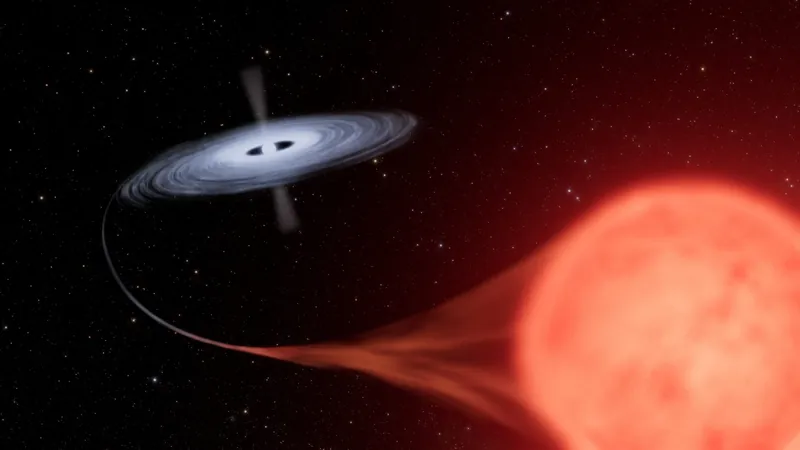
Revolutionary Discovery: Your Smartphone's Power Source Linked to Ancient Nova Explosions!
2025-07-08
Author: Li
The Cosmic Connection: Lithium from Stars!
Did you know that thermonuclear explosions on white dwarf stars are essentially cosmic "lithium factories"? Recent groundbreaking research has uncovered a gamma-ray signal — the first solid evidence that these stellar eruptions are responsible for generating the lithium that fuels our modern gadgets, from smartphones to electric vehicles.
A Mysterious Element's Journey Through Time
Lithium, one of the heaviest elements birthed during the Big Bang, now plays a vital role in technology. However, it has long puzzled astronomers. While hydrogen and helium made up the bulk of the universe's first elements, lithium was found only in trace amounts. Surprisingly, most stars we observe have even lower lithium content than expected!
Where's the Lithium Hiding?
Scientists theorize that as stars age, they lose their outer layers, dragging lithium down into their cores and destroying it. Yet, younger stars exhibit an intriguing trend: they contain significantly more lithium. What's behind this cosmic mystery?
The Role of Novae: The Stellar Recycling Plant
Enter novae — explosive events occurring on the surface of white dwarfs that accumulate excess matter from a companion star. These stellar remnants, born from sun-like stars reaching their life’s end, exhibit astonishingly bright outbursts. In fact, their name originates from the Latin word for "new," reflecting their appearance in the sky.
The Evidence: Observing Nova V1369 Cen!
Astronomers have suspected that novae could be the key to the lithium puzzle, especially as more sun-like stars transition into white dwarfs. The critical evidence came in December 2013 with the nova V1369 Cen, located in the Centaurus constellation. This event was captured by telescopes, including ESA's INTEGRAL.
In theory, these stellar explosions create lithium when beryllium-7, produced during the nova, decays, emitting gamma rays. Initial distance estimates suggested V1369 Cen was too far for detection, but thanks to the Gaia satellite, astronomers discovered it was actually about 3,200 light-years away — well within reach!
A Breakthrough Discovery!
Upon reevaluating prior data, scientists led by Luca Izzo detected a 478 keV gamma-ray signal from V1369 Cen, suggesting the production of around 100 millionths of the sun’s mass in lithium during the nova. This aligns with visual observations of other novae's lithium production.
A Cautionary Note: Confidence in Findings
However, the detection comes with caveats. The gamma-ray signal's strength is relatively weak, leading to a low significance rating. Scientists prefer high-confidence measurements, yet the observations have sparked excitement. Astronomer Massimo della Valle asserts, "This emission, perfectly timed with the nova’s explosion, suggests a true cosmic connection, reaching statistical significance beyond 3-sigma!"
What Lies Ahead?
While this evidence still requires confirmation, it opens an exciting chapter in our understanding of stellar processes. Next time a nova erupts within gamma-ray telescope range, astronomers are poised to capture more definitive signals, reinforcing the notion that the lithium powering your smartphone may trace back to ancient cosmic explosions. IoT has never looked so stellar!


 Brasil (PT)
Brasil (PT)
 Canada (EN)
Canada (EN)
 Chile (ES)
Chile (ES)
 Česko (CS)
Česko (CS)
 대한민국 (KO)
대한민국 (KO)
 España (ES)
España (ES)
 France (FR)
France (FR)
 Hong Kong (EN)
Hong Kong (EN)
 Italia (IT)
Italia (IT)
 日本 (JA)
日本 (JA)
 Magyarország (HU)
Magyarország (HU)
 Norge (NO)
Norge (NO)
 Polska (PL)
Polska (PL)
 Schweiz (DE)
Schweiz (DE)
 Singapore (EN)
Singapore (EN)
 Sverige (SV)
Sverige (SV)
 Suomi (FI)
Suomi (FI)
 Türkiye (TR)
Türkiye (TR)
 الإمارات العربية المتحدة (AR)
الإمارات العربية المتحدة (AR)